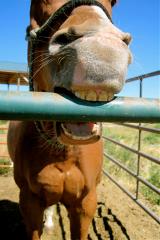Equine Cribbing: An Unwanted Behavioral Habit

Predominantly occurring in stabled horses, cribbing is often explained as an obsessive compulsive behavior shown, for example, when an animal repeatedly bites down on a fence board, arches its neck, grunts, and appears to gulp air. When referring to their animal’s symptoms, clients may describe the observed behaviors as resembling wood chewing or wind sucking.
Damage of Cribbing Horses
Cribbing can cause harm to whatever the horse is biting down upon, for example, stall doors, wood fencing, or stall window frames. However, since the animal is not actually biting and chewing off the wood, the damage does not usually reach total destruction. In addition, since the horse is not biting off and swallowing the wood, most cribbing animals do not typically experience digestive problems.
However, clients need to be made aware that while cribbing is not a disease, it is a behavioral problem that can bring about health issues that can cause their animal to suffer. Examples of these health issues include:
- An animal’s compulsive need to crib may reduce the time that is normally spent feeding or grazing which may have a negative impact on their normal health and body condition as related to their basic nutritional needs
- Identified as a contributing factor of chronic gastritis
- Any reduction in the time a horse normally spends feeding or grazing may alter the normal growth and wear of their incisor teeth which can create dental irregularities
- Splinters that break off from the wood may potentially pierce the soft tissues of the animal’s mouth causing abscesses and infections
- Cribbing has been determined as able to predispose a horse to epiploic foramen entrapment, a type of colic that involves the small intestine
Causes and Deterrents
The reason an animal cribs is not fully understood, but since cribbing is most commonly observed in highly strung animals, and in ones that spend a good portion of their time in a stall, factors that may contribute to this behavior are often considered to be associated with:
- Boredom
- Lack of companionship or social isolation
- Frustration
- Stress
- Inadequate opportunities to exercise, release energy, and reduce tension
Advising clients of ways to minimize cribbing behaviors is important. Simple steps to take include:
- Turning the horse out to pasture with a companion animal, for example: another horse, a donkey, or a goat
- Horses that crib in their stall may be helped by offering them a distraction:
- Hanging a plastic milk jug from the ceiling that they can reach up to bop with their nose
- Hanging up a mirror in the stall that shows their reflection helps them to feel they have a stall companion
One other issue that may be a contributing factor of cribbing includes the animal’s need for more fiber. Advising clients to closely examine their animal’s diet may uncover the necessity to make some nutritional changes.
For example:
- Clients of horses being fed a pellet feed may need to be advised to switch to hay.
- Clients who wish to remain using the pellet feed may need to be advised that they can continue with the pellets, but that long-stemmed hay should also be offered.
- In either situation, the new diet should be examined to make sure it contains all of the animal’s necessary daily requirements.
Prevention
The most typical method to curb cribbing behavior is through the use of a cribbing collar, a leather strap applied snugly around a horse’s throat at the narrowest part of the neck. It should be explained to clients that when positioned properly, cribbing collars are not uncomfortable and do not interfere with breathing, eating, or drinking.
Clients should also be informed of the following:
- The function of the cribbing collar is to tighten when the horse attempts to arch its neck to swallow air
- The tightening of the collar creates a feeling of discomfort which is generally sufficient to stop the animal’s cribbing behavior
- While cribbing collars are usually effective, some animals may still continue the unwanted behavior
The physical action of cribbing has been shown to release endorphins, which helps to explains why horses seem to enjoy the behavior and also identifies why the behavior is so difficult to eliminate. Even with the use of a cribbing collar, most animals will return to the behavior once the collar is removed. Cribbing can also become an observed and learned behavior by other animals pastured with one cribbing animal, which further stresses the need to determine the cause of the behavior.
If interested in learning more about equine behavioral issues, please contact your Covetrus representative at 855.724.3461.
Source:
http://www.petmd.com/horse/conditions/behavioral/c_hr_cribbing
http://largeanimal.vethospitals.ufl.edu/2012/12/11/horse-owner-alert-cribbing-and-colic/Need Regulatory Assistance
If you need help with regulatory or licensing issues, we're happy to help. We have a wide variety of resources to help you when issues arise.

Careers
Are you looking for a place to let your talents shine? At Covetrus, we help our practitioner customers better serve their patients and take pride in providing the best customer experience possible. Search our open positions to see our available opportunities.
Newsletter
Stay current with what’s going on with Covetrus, subscribe to receive our newsletter and email communications. Subscribers will receive the latest information in practice management, sales and marketing, animal health, and more.


Leave a comment